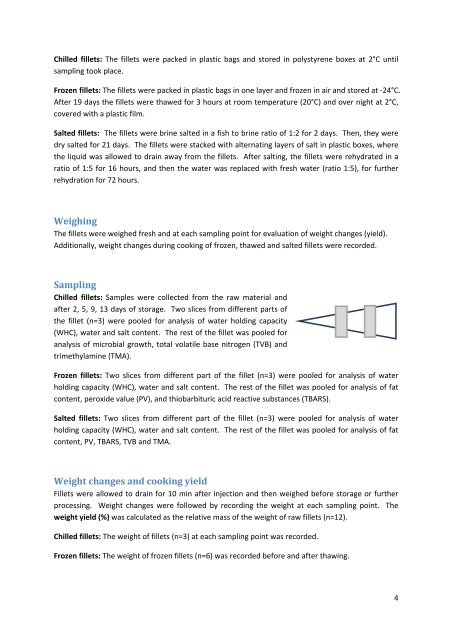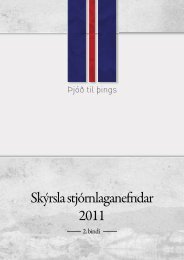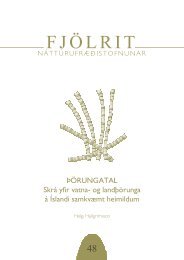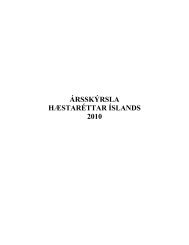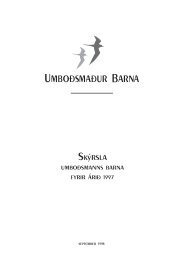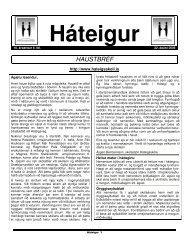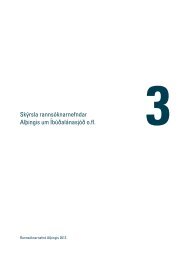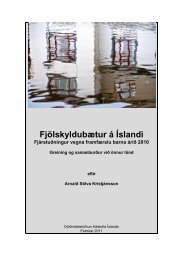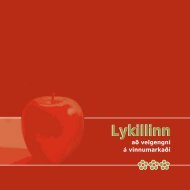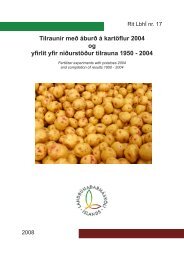Addition of collagen to heavy salted and lightly salted, chilled and ...
Addition of collagen to heavy salted and lightly salted, chilled and ...
Addition of collagen to heavy salted and lightly salted, chilled and ...
Create successful ePaper yourself
Turn your PDF publications into a flip-book with our unique Google optimized e-Paper software.
Chilled fillets: The fillets were packed in plastic bags <strong>and</strong> s<strong>to</strong>red in polystyrene boxes at 2°C until<br />
sampling <strong>to</strong>ok place.<br />
Frozen fillets: The fillets were packed in plastic bags in one layer <strong>and</strong> frozen in air <strong>and</strong> s<strong>to</strong>red at ‐24°C.<br />
After 19 days the fillets were thawed for 3 hours at room temperature (20°C) <strong>and</strong> over night at 2°C,<br />
covered with a plastic film.<br />
Salted fillets: The fillets were brine <strong>salted</strong> in a fish <strong>to</strong> brine ratio <strong>of</strong> 1:2 for 2 days. Then, they were<br />
dry <strong>salted</strong> for 21 days. The fillets were stacked with alternating layers <strong>of</strong> salt in plastic boxes, where<br />
the liquid was allowed <strong>to</strong> drain away from the fillets. After salting, the fillets were rehydrated in a<br />
ratio <strong>of</strong> 1:5 for 16 hours, <strong>and</strong> then the water was replaced with fresh water (ratio 1:5), for further<br />
rehydration for 72 hours.<br />
Weighing<br />
The fillets were weighed fresh <strong>and</strong> at each sampling point for evaluation <strong>of</strong> weight changes (yield).<br />
<strong>Addition</strong>ally, weight changes during cooking <strong>of</strong> frozen, thawed <strong>and</strong> <strong>salted</strong> fillets were recorded.<br />
Sampling<br />
Chilled fillets: Samples were collected from the raw material <strong>and</strong><br />
after 2, 5, 9, 13 days <strong>of</strong> s<strong>to</strong>rage. Two slices from different parts <strong>of</strong><br />
the fillet (n=3) were pooled for analysis <strong>of</strong> water holding capacity<br />
(WHC), water <strong>and</strong> salt content. The rest <strong>of</strong> the fillet was pooled for<br />
analysis <strong>of</strong> microbial growth, <strong>to</strong>tal volatile base nitrogen (TVB) <strong>and</strong><br />
trimethylamine (TMA).<br />
Frozen fillets: Two slices from different part <strong>of</strong> the fillet (n=3) were pooled for analysis <strong>of</strong> water<br />
holding capacity (WHC), water <strong>and</strong> salt content. The rest <strong>of</strong> the fillet was pooled for analysis <strong>of</strong> fat<br />
content, peroxide value (PV), <strong>and</strong> thiobarbituric acid reactive substances (TBARS).<br />
Salted fillets: Two slices from different part <strong>of</strong> the fillet (n=3) were pooled for analysis <strong>of</strong> water<br />
holding capacity (WHC), water <strong>and</strong> salt content. The rest <strong>of</strong> the fillet was pooled for analysis <strong>of</strong> fat<br />
content, PV, TBARS, TVB <strong>and</strong> TMA.<br />
Weight changes <strong>and</strong> cooking yield<br />
Fillets were allowed <strong>to</strong> drain for 10 min after injection <strong>and</strong> then weighed before s<strong>to</strong>rage or further<br />
processing. Weight changes were followed by recording the weight at each sampling point. The<br />
weight yield (%) was calculated as the relative mass <strong>of</strong> the weight <strong>of</strong> raw fillets (n=12).<br />
Chilled fillets: The weight <strong>of</strong> fillets (n=3) at each sampling point was recorded.<br />
Frozen fillets: The weight <strong>of</strong> frozen fillets (n=6) was recorded before <strong>and</strong> after thawing.<br />
4


